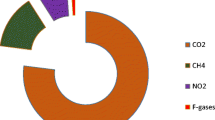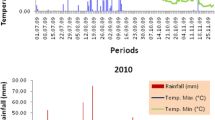Abstract
A field experiment was carried out to determine the emissions of nitrous oxide (N2O) and methane (CH4) and yield of rice grains under water management of continuously flooded (CF) and non-continuously flooded (NCF) systems and to find out those were affected by both input of water managements in combination with urea granulated with nitrification inhibitors (neem and dicyandiamide) and zeolite. Urea combined with zeolite and nitrification inhibitors (NIs) reduced the emission of N2O in both plots of CF and NCF compared with urea alone, while the release of CH4 was induced, especially at CF plot. However, no differences existed in the emissions of N2O and CH4 between the types of urea granulated with zeolite and NIs and urea treatments in both water input managements. A paired comparison between CF and NCF plots revealed fewer emissions of N2O and CH4 in NCF plot with urea granulated with zeolite and neem treatments. Urea with zeolite and NIs did not have any effect on improving rice grain yield different from the effect of urea alone. The nitrogen use efficiency employed in this study had little effect on delayed oxidation of NH4+ in the soil of both plots of rice field. The study showed that the water management or practice of irrigation promises to reduce the emissions of N2O and CH4 compared to nitrogen use efficiency application.


Similar content being viewed by others
References
Abbasi MK, Hina M, Tahir MM (2011) Effect of Azadirachta indica (neem), sodium thiosulphate and calcium chloride on changes in nitrogen transformations and inhibition of nitrification in soil incubated under laboratory conditions. Chemosphere 82:1629–1635
Aguilera E, Lassaletta L, Cobena A, Garnier J, Vallejo A (2013) The potential of organic fertilizers and water management to reduce N2O emissions in Mediterranean climate cropping systems. A review. Agric Ecosys Environ 164:32–52
Ahmed OH, Aminuddin H, Husni MHA (2008) Reducing ammonia loss from urea and improving soil-exchangeable ammonium retention through mixing triple superphosphate, humic acid and zeolite. Soil Use Manag 22:315–319
Akiyama H, Yan XY, Yagi K (2010) Evaluation of effectiveness of enhanced-efficiency fertilisers as mitigation options for N2O and NO emissions from agricultural soils: meta-analysis. Glob Chang Biol 16:1837–1846
Akiyama H, Morimoto S, Hayatsu M, Hayakawa A, Sudo S, Yagi K (2013) Nitrification, ammonia–oxidizing communities, and N2O and CH4 fluxes in an imperfectly drained agricultural field fertilized with coated urea with and without dicyandiamide. Biol Fertil Soils 49:213–223
Anderson JM, Ingram JSI (1989) Colorimetric determination of ammonium. In: Tropical soil bio fertility ISSS. CAB International Wallingford, pp 42–43
Audet J, Hoffmann CC, Andersen PM, Baattrup-Pedersen A, Johansen JR, Søren E, Larsen SE, Kjaergaard C, Elsgaard L (2014) Nitrous oxide fluxes in undisturbed riparian wetlands located in agricultural catchments: emission, uptake and controlling factors. Soil Bio Biochem 68:29–299
Barison J, Uphoff N (2011) Rice yield and its relation to root growth and nutrient-use efficiency under SRI and conventional cultivation: an evaluation in Madagascar. Paddy Water Environ 9:65–78
Beare MH, Gregorich EG, St-Georges P (2009) Compaction effects on C2O and N2O production during drying and rewetting of soil. Soil Biol Biochem 41:611–621
Benckiser G, Christ E, Herbert T, Weiske A, Blome J, Hardt M (2013) The nitrification inhibitor 3,4-dimethylpyrazole-phosphat (DMPP)—quantification and effects on soil metabolism. Plant Soil 371:257–266
Bouyoucos CJ (1962) Hydrometer method improved for making particle size analyses of soils. Agron J 54:464–465
Bray RH, Kurtz LT (1945) Determination of total organic and available forms of phosphorus in soils. Soil Sci 59:39–46
Burt R (2004). Soil survey laboratory methods manual. Soil survey investigations report 42, Version 4.0. United States Department of Agriculture. Natural Resources Conservation Service, National Soil Survey Center
Cai ZC, Yan XY, Yan G, Xu H, Tsuruta H, Yagi K, Minami K (1997) Methane and nitrous oxide emissions from rice paddy fields as affected by nitrogen fertilizers and water management. Plant Soil 196:7–14
Carreres R, Sendra J, Ballesteros R, Valiente EF, Quesada A, Carrasco D, Leganes F, Garcia dela Cuadra J (2003) Assessment of slow release fertilizers nitrification inhibitors in flooded rice. Biol Fert Soils 39:80–87
Datta A, Adhya TK (2014) Effects of organic nitrification inhibitors on methane and nitrous oxide emission from tropical rice paddy. Atmos Environ 92:533–545
Dong H, Yao Z, Zheng X, Mei B, Xie B, Wang R, Deng J, Cui F, Zhu J (2011) Effect of ammonium-based, non-sulfate fertilizer on CH4 emissions from a paddy field with a typical Chinese water management regime. Atmos Environ 45:1095–1101
Ferguson GA, Pepper IL (1987) Ammonium retention in sand amended with clipnoptilolite. Soil Sci Soc Am J 51:231–234
Foster JC (1995) Soil physical analysis. In: Alef K, Nannipieri P (eds) Methods in applied soil microbiology and biochemistry. Academic Press, London, pp 105–106
Haque MdM, Biswas JC, Kim SY, Kim PJ (2017) Intermittent drainage in paddy soil: ecosystem carbon budget and global warming potential. Paddy Water Environ 2017(15):403–411
Hayashi A, Sakamoto K, Yoshida T (1997) A rapid method for determination of nitrate in soil by hydrazine reduction procedure. Jpn J Soil Sci Plant Nutr 68:322–326
Hoeung P, Bindar Y, Senda SM (2011) Development of granular urea-zeolite slow release fertilizer using inclined pan granulator. J Teknik Kimia Indones 10:102–111
Huang ZT, Petrovic AM (1994) Clinoptilolite zeolite influence on nitrate leaching and nitrogen use efficiency in simulated sand based golf greens. J Environ Qual 23(6):1190–1194
Inubushi K, Hori K, Matsumoto S, Umebayashi M, Wada H (1989) Methane emission from the flooded paddy soils to the atmosphere through rice plant. Jpn J Soil Sci Plant Nutr 60:318–324
Inubushi K, Sugii H, Watanabe I, Wassmann R (2002) Evaluation of methane oxidation in rice plant-soil system. Nutr Cycl Agroecosyst 64:71–77
IPCC (2007) Summary for policymakers. In: Climate change 2007: the physical science basis. Contribution of working group I to fourth assessment report of IPCC. Cambridge University Press, Cambridge, UK and New York, USA use efficiency in simulated sand–based golf greens. J. Environ Quality, vol 23, pp 1190–1194
Jumadi O, Hala Y, Muis A, Ali A, Palennari M, Yagi K, Inubushi K (2008) Influences of chemical fertilizers and a nitrification inhibitor on greenhouse gas fluxes in a Corn (Zea mays L.) field in Indonesia. Microbes Environ 23:29–34
Jumadi O, Ali A, Hala Y, Muis A, Yagi K, Inubushi K (2012) Effect of controlled water level on CH4 and N2O emission from rice fields in Indonesia. Trop Agric Dev 56:129–138
Kithome M, Paul JW, Lavkulich LM, Bomke AA (1998) Kinetics of ammonium adsorption and desorption by the natural zeolite clinoptilolite. Soil Sci Soc Am J 62:622–629
Kudo Y, Noborio K, Shimoozoo N, Kurihara R, Minami H (2016) Greenhouse gases emission from paddy soil during the fallow season with and without winter flooding in central Japan. A short communication. Paddy Water Environ 15:217–220
Le Mer J, Roger P (2001) Production, oxidation, emission and consumption of methane by soil: a review. Eur J Soil Biol 37:25–50
Linquist BA, Borbe MAA, Pittelkow CM, Kessel CV, Groenigen KJV (2012) Fertilizer management practices and greenhouse gas emissions from rice systems: a quantitative review and analysis. Field Crops Res 135:10–21
Ma J, Li XL, Xu H, Han Y, Cai ZC, Yagi K (2007) Effects of nitrogen fertilizer and wheat straw application on CH4 and N2O emissions from a paddy rice field. Aust J Soil Res 45:359–367
Majumdar D (2005) Crop yield and soil nitrogen dynamics in an intermittently flooded rice field affected by nitrification inhibitors. Arch Agro Soil Sci 51:645–653
Majumdar D, Kumar S, Pathak H, Jain MC, Kumar U (2000) Reducing nitrous oxide emission from an irrigated rice field of North India with nitrification inhibitors. Agric Ecosys Environ 81:163–169
McCarty GW (1999) Modes of action of nitrification inhibitors. Biol Fertil Soils 29:1–9
Mohanty S, Patra AK, Chhonkar PK (2008) Neem (Azadirachta indica) seed kernel powder retards urease and nitrification activities in different soils at contrasting moisture and temperature regimes. Bioresour Technol 99:894–899
Mohanty S, Bharati K, RaoVR Adhya TK (2009) Dynamics of changes in methanogenesis and associated microflora in a flooded rice field following repeated application of dicyandiamide, a nitrification inhibitor. Microbiol Res 164:71–80
Opoku A, Chaves B, Neve SD (2014) Neem seed oil: a potent nitrification inhibitor to control nitrate leaching after incorporation of crop residues. Biol Agric Hortic 30:145–152
Page AL, Miller RH, Keeney DR (1982) Methods of soil analysis, Part 2-chemical and microbiological properties, 2nd edn. American Society of Agronomy, Madison
Prasad R, Power J (1995) Nitrification inhibitors for agriculture, health and strategies for balanced fertilization. Fertil News 49:73–80
Roy RN, Frink A, Blair GJ, Tandon HLS (2006) Plant nutrition for food security. FAO Fertil Plant Nutr Bull 16:141–186
Ruser R, Schulz R (2015) The effect of nitrification inhibitors on the nitrous oxide (N2O) release from agricultural soils—a review. J Plant Nutr Soil Sci 178:171–188
Schimel J (2000) Global change: rice, microbes and methane. Nature 403(6768):375
Sharma SN, Prasad R (1996) Use of nitrification inhibitors (neem and DCD) to increase N efficiency in maize-wheat cropping system. Fertil Res 44:169–175
Singla A, Inubushi K (2015) Effect of slag-type fertilizers on N2O flux from komatsuna vegetated soil and CH4 flux from paddy vegetated soil. Paddy Water Environ 13:43–50
Subardja D, Ritung S, Anda M, Sukarman, Suryani E, Subandiono RE (2014) National land classification technical instructions. Center for agricultural land resources research and development of Indonesia (in Indonesian)
Tarkalson DD, Ippolito JA (2011) Clipnoptilolite zeolite influence on nitrogen in a manure amended sandy agriculture soil. Com Soil Sci Plant Anal 42:2370–2378
Tate KR (2015) Soil methane oxidation and land-use change from process to mitigation. Soil Biol Biochem 80:260–272
Trenkel M (1997) Improving fertilizer use efficiency controlled release and stabilized fertilizers in agriculture. Inter Ferti Ind Assoc, Paris. ISBN 2-9506299-0-3
USA. Department of Agriculture Natural Resources Conservation Service, Soil Survey Staff (1998). Keys to soil taxonomy. USDA
Wassmann R, Lantin RS, Neue HU, Buendia LV, Corton TM, Lu Y (2000) Characterization of methane emissions from rice fields in Asia. III. Mitigation options and future research needs. Nutr Cycl Agroecosyst 58:23–36
Weiske A, Benckiser G, Herbert T, Ottow JCG (2001) Influence of the nitrification inhibitor 3,4-dimethylpyrazole phosphate (DMPP) in comparison to dicyandiamide (DCD) on nitrous oxide emissions, carbon dioxide fluxes and methane oxidation during 3 years of repeated application in field experiments. Biol Fertil Soils 34:109–117
Xie B, Zheng X, Zhou Z, Gu J, Zhu B, Chen X, Shi Y, Wang Y, Zhao Z, Liu C, Yao Z, Zhu J (2010) Effects of nitrogen fertilizer on CH4 emission from rice fields: multi-site field observations. Plant Soil 326:393–401
Yang S, Peng S, Xu J, He Y, Wang Y (2015) Effects of water saving irrigation and controlled release nitrogen fertilizer management on nitrogen losses from paddy fields. Paddy Water Environ 13:71–80
Acknowledgements
These works were supported by Institutional Collaborative Agriculture Research (Hibah KKP3N) of Ministry of Agriculture and Ministry of Research, Technology and Higher Education of the Republic of Indonesia (Hibah Penelitian Kompetensi). We are very thankful to Adriani, Nurul Fajratullah, and Juniarti of Department Biology, Universitas Negeri Makassar, and Junja Baba of Soil Science Laboratory, Chiba University, for all valuable works during the experiments.
Author information
Authors and Affiliations
Corresponding author
About this article
Cite this article
Jumadi, O., Hartono, H., Masniawati, A. et al. Emissions of nitrous oxide and methane from rice field after granulated urea application with nitrification inhibitors and zeolite under different water managements. Paddy Water Environ 17, 715–724 (2019). https://doi.org/10.1007/s10333-019-00724-3
Received:
Revised:
Accepted:
Published:
Issue Date:
DOI: https://doi.org/10.1007/s10333-019-00724-3




